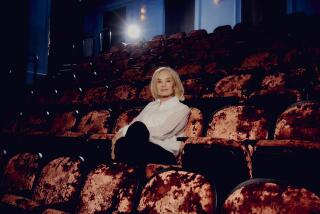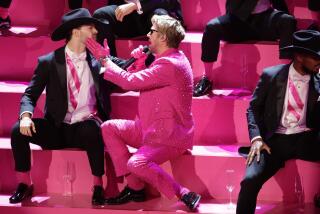‘La La Land’ seriously misunderstands music. So why are its songs pretty great?
To prepare for the role of Sebastian — the hardheaded jazz preservationist in Damien Chazelle’s “La La Land,” which is nominated for a record-tying 14 Oscars at Sunday’s Academy Awards — Ryan Gosling says he spent three months learning to play piano.
“It’s a lot of time alone, and you become quite anti-social,” he told ABC’s “Nightline” of the experience. “Every time I tried to have a conversation during that rehearsal period with anybody, it was a bit like Bambi on ice.”
He needn’t have taken it quite so seriously.
A lavish movie musical set amid Los Angeles’ young creative class, “La La Land” is dimmest in its depiction of how musicians think and behave. Whenever we see a character pick up a horn or sit down behind a piano — or even open his mouth to hold forth on the supremacy of the past — the film bogs down in childish clichés about compromise and authenticity.
But here’s the curious thing about this polarizing movie that gets so much wrong about the purpose and value of art: When “La La Land” uses music in the manner of the classic musicals it’s obviously emulating — not to put us inside a world but to take us out of one — the movie achieves liftoff.
You get a sense early on that “La La Land” is going to have problems when it shows us Sebastian debasing himself for a paycheck at a party in the Hollywood Hills. By this point, we’re already meant to understand that he’s a genuine artist, yet here he is forced to play keytar in a cheesy ’80s-pop cover band — a humiliation made only worse by the arrival of Mia, a woman he’d like to impress, played by Emma Stone.
There’s no mistaking the tone of pity in this scene. But the cover band sounds great blazing through “I Ran” by A Flock of Seagulls. As a viewer, you identify with miserable Sebastian far less than you do the tipsy, half-dressed starlets cheering from the swimming pool.
Yet “La La Land” asks you to distrust your reaction — to accept the movie’s outdated idea that pop isn’t worthy of respect.
What is worthy, according to the film? Sebastian, alone in his honorably dingy apartment, plucking out the dreary “City of Stars,” one of two numbers by composer Justin Hurwitz and lyricists Benj Pasek and Justin Paul nominated at the Oscars for original song. (The other, “Audition (The Fools Who Dream),” is much better — more on that in a minute.)

This screwy value system asserts itself again in a scene where Sebastian, performing with the slick soul-funk band he’s joined at the invitation of his old frenemy Keith (played by John Legend), ignites a crowd with the very tepid “Start a Fire” — a clear indication of how out of touch Chazelle is with the real-world pop he so eagerly denigrates.
Then there are the countless instances of Sebastian mansplaining the importance of jazz — “pure jazz,” as he puts it, without elaborating — to Mia, whose blank expression could be taken as welcome skepticism if the film allowed the character to express an opinion of her own.
This stuff isn’t just insufferable; it’s unrecognizable as an attitude anyone in 2017 might adopt.
“La La Land” is hardly the first movie to misunderstand music. Most films about this wonderfully complicated subject have trouble capturing how music works, including Chazelle’s previous project, “Whiplash,” which demonstrates the abuse a young jazz drummer is willing to take from a sadistic teacher without demonstrating why he’s willing to take it.
But few movies as dumb about music as this one are also as alive to its emotional potential.
In scenes where the film’s characters aren’t the ones making noise — where a song simply materializes because that’s what happens in a musical — “La La Land” throbs with sensation, be it the opening sequence set on an L.A. freeway (“Another Day of Sun”), a number in which Mia and her girlfriends get ready for a night on the town (“Someone in the Crowd”) or the gorgeous dream ballet near the end of the movie (“Epilogue”) in which Sebastian and Mia float through an imagined version of their life together.
Most effective of all might be “Audition,” a solo for Stone that she performs largely in close-up, her face cycling through nearly every conceivable feeling as the music keeps swelling and receding.

Are these elaborate production numbers helped along by filmmaking razzle-dazzle? Of course. There’s also the ample star power of two headliners who can’t really sing or dance (but can gaze like nobody’s business).
Yet with their swooping melodies, lively rhythms and lush Old Hollywood arrangements, Hurwitz’s songs — the best ones, anyway — are doing plenty of the work here. And they’re doing it in a knowing, hybridized way that undermines Sebastian’s stultifying obsession with purity.
“La La Land’s” music director is Marius de Vries, who’s known for his production on records by such genre-indifferent performers as Madonna and Björk — not to mention his involvement in Baz Luhrmann’s “Moulin Rouge,” that postmodern movie musical with all kinds of smart things to say about how pop music functions in people’s lives.
Some have suggested that the sophistication of “Someone in the Crowd” and “Audition” should lead us to conclude that Sebastian’s laughable position on music isn’t necessarily the position of the film.
The director himself tried to make that case recently on NPR’s “Fresh Air,” saying, “I definitely don’t personally endorse or espouse Ryan Gosling’s character’s views.” Chazelle added that he conceived of Sebastian as a version of his close-minded younger self, when his “idea of art was very exclusionary.”
But that’s not terribly convincing. For one thing, “Whiplash” upholds the same moral absolutism as “La La Land” in its portrayal of a kid who looks at music as a fortress to be defended.
How many more movies about unsmiling jazz musicians can we expect from Chazelle before he cops to sympathizing with their grim determination?
But consider too the vision of artistic fulfillment that “La La Land” ultimately provides, after that beautiful dream ballet ends and we’re dropped back into a years-hence reality, where Sebastian is behind a piano at the nightclub he’s always wanted to open.
The camera starts tight on the keys, then pulls back and reveals our hero, still somber but finally playing just what he wants — a success not because he’s happy but because he stuck to his guns.
Twitter: @mikaelwood
ALSO
Here’s who’s going to win all 24 Oscar categories
Where ‘La La Land’ was shot in L.A., scene by scene
The red carpet isn’t actually red, and other secrets underfoot at the Oscars
More to Read
The biggest entertainment stories
Get our big stories about Hollywood, film, television, music, arts, culture and more right in your inbox as soon as they publish.
You may occasionally receive promotional content from the Los Angeles Times.











